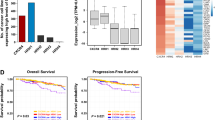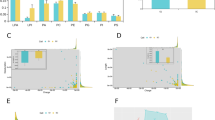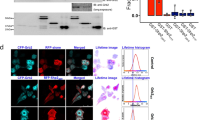Abstract
Phorbol esters are potent tumour-promoting agents that exert pleiotropic effects on cells1–3. Among these are the control of growth4, stimulation of release of stored bioactive constituents5–8 and regulation of growth-factor surface receptors9–13. Phorbol esters bind to and activate protein kinase C, leading to the phosphorylation of specific protein substrates presumed to be necessary for eliciting the full response6,8–12,14,15. Strong evidence exists that specific binding of tumour promoter occurs at the membrane level in intact cells, resulting in activation of protein kinase C16,17. Recent evidence concerning the release of bioactive constituents from platelets5,8,14,18,19 and neutrophils5,6 has linked agonist-induced protein kinase C activation and Ca2+ mobilization in a synergistic mechanism8,20,21. Here we present a novel model of synergism between Ca2+ and phorbol esters that leads to transferrin receptor phosphorylation and down-regulation in HL-60 human leukaemic cells. Raising intracellular Ca2+, although ineffective by itself, increases the potency and rate of action of phorbol ester for activating protein kinase C and mediating transferrin receptor phosphorylation and down-regulation. We propose a molecular model in which increased intracellular Ca2+ recruits protein kinase C to the plasma membrane, thus ‘priming’ the system for activation by phorbol ester.
This is a preview of subscription content, access via your institution
Access options
Subscribe to this journal
Receive 51 print issues and online access
$199.00 per year
only $3.90 per issue
Buy this article
- Purchase on Springer Link
- Instant access to full article PDF
Prices may be subject to local taxes which are calculated during checkout
Similar content being viewed by others
References
Wertz, P. W. & Mueller, G. C. Cancer Res. 38, 2900–2904 (1978).
Diamond, L., O'Brien, T. & Rovera, G. Life Sci. 23, 1979–1988 (1978).
Rovera, G., Santoil, D. & Damsky, C. Proc. natn. Acad. Sci. U.S.A. 76, 2779–2783 (1979).
Cooper, R. A., Brunwald, A. D. & Kuo, A. L. Proc. natn. Acad. Sci. U.S.A. 79, 2865–2869 (1982).
Sha'afi, R. I. et al. Biochem. biophys. Res. Commun. 114, 638–645 (1983).
White, J. R. et al. J. biol. Chem. 259, 8605–8611 (1984).
DiVirgilio, F., Lew, D. P. & Pozzan, T. Nature 310, 691–693 (1984).
Nishizuka, Y. Nature 308, 693–697 (1984).
May, W. S. Jr, Jacobs, S. & Cuatrecasas, P. Proc. natn. Acad. Sci. U.S.A. 81, 2016–2020 (1984).
Cohen, S., Carpenter, G. & King, L. J. biol. Chem. 255, 4834–4842 (1980).
Cooper, J. A., Bowen-Pope, D. F., Raines, E., Ross, R. & Hunter, T. Cell 31, 263–273 (1982).
Jacobs, S. J., Sahjoun, N., Saltiel, A. S. & Cuatrecasas, P. Proc. natn. Acad. Sci. U.S.A. 80, 6211–6213 (1983).
Iwashita, S. & Fox, C. F. J. biol. Chem. 259, 2559–2567 (1984).
Fujikura, T. & Nishizuka, Y. J. biol. Chem. 258, 6701–6704 (1983).
Rovera, G. et al. Ann. N.Y. Acad. Sci. 397, 211–220 (1982).
Castagna, M. et al. J. biol. Chem. 257, 7847–7851 (1982).
Niedel, J. E., Kuhn, L. J. & Vandenbark, G. P. Proc. natn. Acad. Sci. U.S.A. 80, 36–40 (1983).
Kaibuchi, K., Sano, K., Hoshijima, M., Takai, Y. & Nishzuka, Y. Cell Calcium 3, 323–335 (1982).
Yamanishi, J. et al. Biochem. biophys. Res. Commun. 112, 778–786 (1983).
Sutherland, R. et al. Proc. natn. Acad. Sci. U.S.A. 78, 4515–4519 (1981).
May, W. S., Sahyoun, N., Jacobs, S., Wolf, M. & Cuatrecasas, P. J. biol. Chem. 260, 9419–9426 (1985).
May, W. S. Jr, Sayhoun, N. E., Le Vine, H. III, Jacobs, S. & Cuatrecasas, P. Clin. Res. 32, 498A (1984).
Wolf, M., LeVine, H. III, May, W. S. Jr, Cuatrecasas, P. & Sahyoun, N. Nature 317, 546–551 (1985).
Kraft, A. S. & Anderson, W. B. Nature 301, 621–623 (1983).
Klausner, R. D., Harford, J. & van Renswonda, J. Proc. natn. Acad. Sci. U.S.A. 81, 3005–3009 (1984).
Nishizuka, Y. Trends biochem. Sci. 8, 13–16 (1983).
Laemmli, U. K. Nature 227, 680–685 (1970).
Author information
Authors and Affiliations
Rights and permissions
About this article
Cite this article
May, W., Sahyoun, N., Wolf, M. et al. Role of intracellular calcium mobilization in the regulation of protein kinase C-mediated membrane processes. Nature 317, 549–551 (1985). https://doi.org/10.1038/317549a0
Received:
Accepted:
Published:
Issue Date:
DOI: https://doi.org/10.1038/317549a0
This article is cited by
-
Protein kinase C in IL- 2 signal transduction
Immunologic Research (1997)
-
Doxycycline reduction of f-actin content of human neutrophils and fibroblasts
Inflammation (1994)
-
Alterations in intracellular calcium transients of fibroblasts from progressive systemic sclerotic patients: a digital imaging microscopic study
Archives of Dermatological Research (1991)
-
Protein phosphorylation associated with the stimulation of neutrophils. Modulation of superoxide production by protein kinase C and calcium
Journal of Bioenergetics and Biomembranes (1990)
-
Cellular and intracellular pathways mediating the metamorphic stimulus in hydrozoan planulae
Roux's Archives of Developmental Biology (1990)
Comments
By submitting a comment you agree to abide by our Terms and Community Guidelines. If you find something abusive or that does not comply with our terms or guidelines please flag it as inappropriate.



